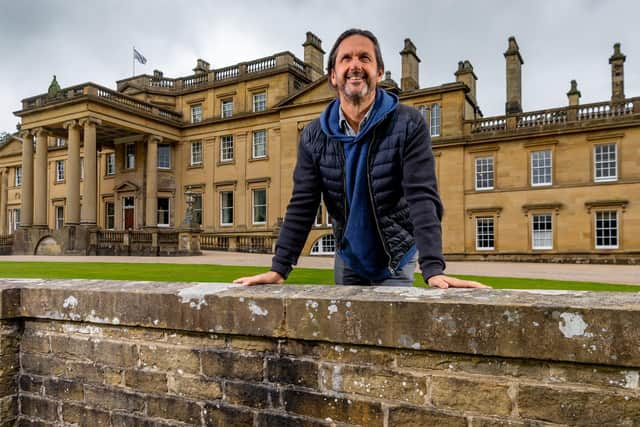'We've gone from Downton Abbey to a sanctuary': How Broughton Hall shows how Yorkshire's historic houses can move with the times


When you are the 32nd generation of your family to look after your country home and 3,000-acre estate, respecting the past while evolving for the future is an ongoing challenge.
That has been the balancing act for Roger Tempest at Broughton Hall, which has been the home of the Tempest family since 1097..
Advertisement
Hide AdAdvertisement
Hide AdThe Tempests are one of England’s oldest Catholic landed gentry families after coming to England from Normandy as part of William the Conqueror’s invasion in 1066, so their history could barely be more rich - but the estate has very much moved with the times.


“To put it simply, we have gone from Downton Abbey to a sanctuary,” Mr Tempest explained over a Zoom call. “There is a fundamental change and reimagination of what we have been doing here.”
The estate now includes everything from holiday homes to a wellbeing centre and an addiction clinic - as well as office space for more than 50 companies and 700 workers. Among the most notable businesses based in Broughton are Silver Cross Prams.
Mr Tempest said: “We have 700 jobs based here. There are about 100 people who live in the parish and there are over 700 jobs. That is an extraordinary figure. I never thought it would work but it works amazingly.
“The engine house of change is enterprise.”
Advertisement
Hide AdAdvertisement
Hide AdThe estate’s new role in the local community has been highlighted in the new report commissioned by the York and North Yorkshire Local Enterprise Partnership (LEP) and Historic England as an example of how heritage assets in the region can find new purposes.
The report states: “Permanent changes of use to historic estate buildings have a role to play, even where they may not lend themselves to residential conversion.
“Complexes of estate offices, farmsteads and so on which have lost their original, specialist use or are no longer fit for agricultural purposes have become host to small business units, childcare facilities and a range of other facilities which fulfil local needs.
“Broughton Hall workspaces near Skipton are an example of the successful integration of contemporary design within historic spaces to create attractive locations for business and events, part of a wider transformation of an ancient, landed estate.”
Advertisement
Hide AdAdvertisement
Hide AdThe estate is also aiming to play a wider role in the community and has been engaged in a mass rewilding project with about 250,000 new trees planted so far. At a different level, it has also recently hosted a Tough Mudder obstacle course that has raised around £250,000 for charity.
The grounds have also been used by many film crews in recent years for television shows including All Creatures Great And Small and Gentleman Jack.
“We are busy, busy, busy,” said Mr Tempest. “We have got 1,000 years of history but gone are the days of holing up privately. Those days went years ago and we are very active in the community.
“I’m 58 and have been working here for 30 years. I’m motivated every morning to make this place a force for good and make it a happy and successful place.
Advertisement
Hide AdAdvertisement
Hide Ad“Privilege without responsibility is a very ugly thing. When you are in a job like mine, it is a huge privilege to be a guardian of this beautiful bit of Yorkshire. You just have to be part of the recipe. At times it is very demanding and a 24-hour job. But it can be really rewarding. If you are planting a quarter of a million trees it is just so satisfying to see what is happening.”
Helen Simpson, the chairwoman of the York and North Yorkshire LEP, says that in addition to Broughton Hall there are many other examples of how economic development and heritage protection can dovetail together in North Yorkshire.
She said the Treadmills development on the site of the former Northallerton prison which involves a mixture of retail and business uses shows how historic but unloved buildings can be given a new lease of life.
“It was one of the oldest prisons in the country, the Prison Service moved out a few years ago and it has been standing there looking derelict and dreadful right in the heart of Northallerton, the market town and county town of North Yorkshire, and it just made the place look sad.
Advertisement
Hide AdAdvertisement
Hide Ad“The local district council Hambleton worked with the LEP and a whole range of other partners and it is a really great makeover.
“They are just getting it open. What was the main prison block is now an accelerator and meeting point for start-ups.
“It is a collaboration incubator space - it is just great to see something so historic getting used for growing the future.”
She said another example of allowing historic buildings to move with the times is the Guildhall in York, which has been a seat of civic governance in the city since 1200 and is currently undergoing £21m of refurbishment work which will restore it to its former glory and provide new office and community space.
Advertisement
Hide AdAdvertisement
Hide Ad“The Guildhall in York is a fantastic historic building that has been looking a bit tatty and needed to find a new purpose in life,” Ms Simpson added.
“There has been a partnership between the City of York, us as the LEP and the university. It is doing a great job of turning the Guildhall into a centre that will support tiny businesses.
“There is a power about the Guildhall. In the Middle Ages, all the members of the Guild got together in the Guildhall to sort out how they could grow their businesses and how best to flourish. I guess some of these projects are about finding the 21st Century version of that.”
The new report talks about viewing the region’s heritage assets as a complement to sympathetic development rather than a barrier to it - something very much echoed by Trevor Mitchell, the regional director from Historic England.
Advertisement
Hide AdAdvertisement
Hide Ad“It has long been our view that our heritage assets are exactly that - assets,” he said. “The development industry can see them as liabilities but if you look at a place like North Yorkshire, heritage is everywhere.
“Heritage is an opportunity that we should be grasping, not something to try and avoid.”
Ms Simpson added: “At the moment we have a lot of historic assets with a lot of potential.
“My dream would be that in ten years’ time a lot of that potential is realised and we see some of our amazing historic buildings have found their way to their new life.”
Advertisement
Hide AdAdvertisement
Hide AdSupport The Yorkshire Post and become a subscriber today. Your subscription will help us to continue to bring quality news to the people of Yorkshire. In return, you'll see fewer ads on site, get free access to our app and receive exclusive members-only offers. Click here to subscribe.
Comment Guidelines
National World encourages reader discussion on our stories. User feedback, insights and back-and-forth exchanges add a rich layer of context to reporting. Please review our Community Guidelines before commenting.